14 Apr Sustainable Practices
Posted at 14:45h
in
MeStyle,
Opinion
by Studio Faro
The tug of war between our creative drive and our ethical aspirations can be so confusing. How can we adjust our own consumption of fabric/fashion so that we can satisfy our creative needs, alongside supporting our social, ethical and environmental ideals?
To begin with we’re so fortunate if we can sew. Already we’re able to side-step the ugly world of fast fashion when we have the skills and resources to make our own clothes. So what are the key issues we need to consider if we are to grapple with our creativity and still hold some ethical views on consumption.
This post is primarily focused on readers who sew their own clothes. If you’re not inclined to sew then you might decide that your approach to new fashion clothing is to utilise the services of a local dressmaker. If you do you’ll be able to engage in some of the sustainable practices featured in this article while supporting a small local business. I call that a win-win!
The Issues
The High Cost of Fast Fashion
I’m going to start this conversation with the greatest villain in the room, Fast Fashion. Or maybe not. As sewing creatives we can easily side-step this issue and not participate in the fast fashion game at all.
For the non-sewing readers I’m sure you’ve heard many of the arguments around this issue. Rather than bang on about this issue I’ll just leave a few links here for anyone wanting to revisit this issue.
There are so many articles/projects about the high cost of fast fashion. Here are a couple to start you off:
“You go into certain stores…” – she throws a dark look – “how they can sell clothes for that price, when I couldn’t even buy the fabric for that much? And then you hear about things that happen [in the factories] in the far east.”
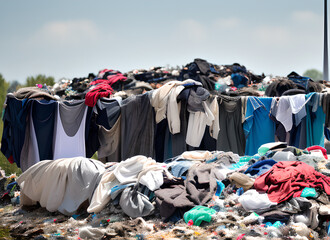
The ABC’s fabulous documentary television series ‘War on Waste’.
‘Discarded is an exploration of the short and uneventful lives led by fast fashion garments from brands with headquarters in the UK, focussing on brands with their headquarters in Manchester. From garments in charity shops that have never been worn, to garments thrown out with household rubbish, this project seeks to highlight the waste of resources, the exploitation of workers and the pollution problems that the overproduction of fast fashion causes, and to create new and exciting realities for these unwanted garments. The project will culminate in an exhibition during Fashion Revolution Week in April 2023, to commemorate the 10th anniversary of the Rana Plaza factory collapse.
A thread that outlines the real cost of clothing:
Ethical Fashion is so Confusing – even shoppers with good intentions get overwhelmed – from The Conversation
Solutions
Quality over Quantity
Who would have thunk it! Fantasy fiction helps us understand the best kind of consumption. Not sure where I found this reference but it’s such a clear and wonderful example of the smart consumption.
The Captain Samuel Vimes ‘Boots’ theory of socioeconomic unfairness. Terry Pratchett, Men at Arms
‘The reason that the rich were so rich, Vimes reasoned, was because they managed to spend less money. Take boots, for example. He earned thirty-eight dollars a month plus allowances. A really good pair of leather boots cost fifty dollars. But an affordable pair of boots, which were sort of OK for a season or two and then leaked like hell when the cardboard gave out, cost about ten dollars. Those were the kind of boots Vimes always bought, and wore until the soles were so thin that he could tell where he was in Ankh-Morpork on a foggy night by the feel of the cobbles.
But the thing was that good boots lasted for years and years. A man who could afford fifty dollars had a pair of boots that’d still be keeping his feet dry in ten years’ time, while the poor man who could only afford cheap boots would have spent a hundred dollars on boots in the same time and would still have wet feet.’
A related article:
‘The lesson in this for us makers is that using quality fabric and taking our time to make the best garment possible has the same effect as buying better quality garments in fashion retail. We own them longer. We treasure them more. And they will always have a high re-use, recycle value.’
Cora Harrington on Twitter: ‘Let’s go back to having personal style with longevity.’
Buy Local
You can apply this solution to both fabric, trims, sewing patterns and your equipment. We do still have some fabric manufacturers in Australia and it’s worth searching them out and supporting their work. And we definitely have many fabric suppliers that are Australia based even if they have to buy cloth off-shore. Again support these local businesses to maintain a vibrant textile community. Shipping fabric from overseas companies will contribute pollution and the burning of fossil fuels in the delivery of your goods.
MadeIt– Buy, Sell, Make, Love Australian Made
Shop Local Australia
Re-use, Repair and Recycle
Start with what’s already in your wardrobe. There’re always garments that have not been worn for at least 6-12 months. My method for sorting out these not-so-popular items is to always return freshly washed garments to the front of the rail and this will push the unworn items to the back of the rail. Garments at the back of the rail can then be recycled through charity shops or garment swaps.
Sort out any garments that you’re unable to wear because of missing buttons or damage and repair them and return to the wardrobe.
If you’re in need of new garments or replacements for worn out favourites, try the op-shops first before buying brand new items. Even as a prolific maker of clothing I will always look to re-use second-hand clothing for items I’m not able to make like fully fashioned knits and fabulous vintage pieces.
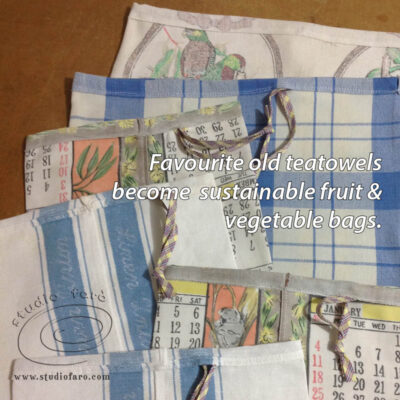
Reduce Waste and Zero-waste
Folk Inspired – source of some of the best zero-waste design ideas. Historic textiles were high value and every single bit of the cloth was used with absolutely no waste.
Technology Inspired – You’ll find many new designs of zero-waste patterns on the internet. It’s fascinating work and quite the challenge to replicate in your workroom.
Patchwork – You can use leftover fabrics and discarded garments to make patchwork fabric that can then be cut into new garments. I haven’t tried this particular approach myself but find the idea of mixing many different prints and colours very enticing.
Craft Projects – small and large cloth scraps can be used to stuff cushions and soft toys.
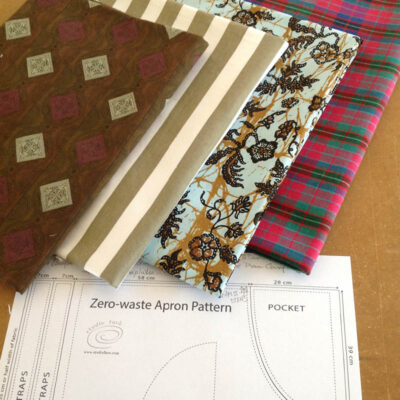
Fabrics purchased from a local craft store that specialises in re-selling fabric stashes from local sources.
Textiles – Do the Research
This has always been the most difficult aspect of an ethical approach to clothing. The production of textiles is fraught with waste, environment damage, wage and worker exploitation, the list goes on. Many suggest that to buy natural fibres is somehow a solution, but I beg to differ. The production of natural fibre textiles is not without it’s controversy regarding waste, pollution and exploitation. The model I do find most attractive is the cycle from origin to end, and how I can build that understanding into my own consumption. If I do have to use the more non-sustainable textiles then I try not to buy new but source them second hand so as not to contribute to future production of textiles.
Some Fabulous Stories & Quotes
Patagonia: Billionaire boss gives fashion firm away to fight climate change
Patrick McDowell, founder of sustainable luxury brand Patrick McDowell
“For 2023 I think we’re moving towards regeneration, circularity and traceability. Practically, this means rewriting business models, remaking, reimagining and really getting to know your supply chain. These are all tangible and real steps we’ve taken ourselves and with the brands we work with to create longer-lasting positive change.”
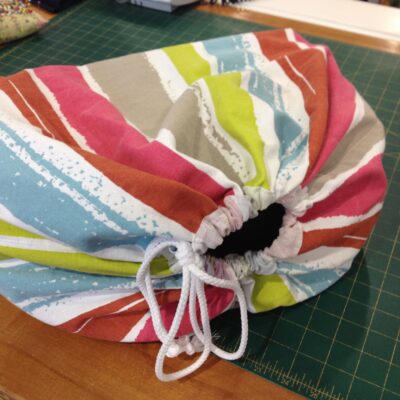
A tablecloth sourced from the Salvo’s and turned into useful drawstring bags. This one a blanket bag.
My Conclusions
I’m going to start by declaring that I know I can’t do it all. These are big issues but it’s my hope to find a way to work them into my creative practice on a day to day basis.
For the coming year I’m going to try the following:
- Buy most of the fabric and trims I use from de-stash groups, op shops and fabric swaps.
- To select and draft patterns that leave a minimal amount of fabric waste.
- Keep my larger scraps and patchwork them into craft projects and new garments.
- Keep my smaller scraps and use them to stuff poufs, cushions and soft toys.
- Pass on any unwanted garments (in best condition) to charity shops.
- Re-use the fabric from my muslins, toiles and test garments in craft projects, making vegetable bags, cleaning rags and stuffing cushions.
Interesting links:
I’d love to hear your ideas about sustainable creativity and how if works in your projects.
Take this moment to sign up for my fabulous newsletter! Every month or so I send an email newsletter with new website content and always, always an enormous discount code for all my sewing patterns, garment blocks and pattern making instructions.
This discount code is for subscribers only. Don't miss out!
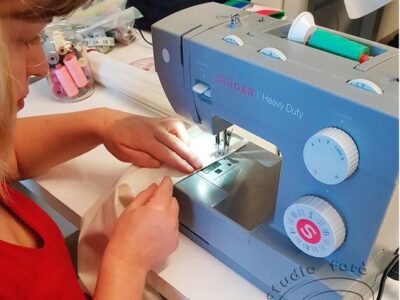
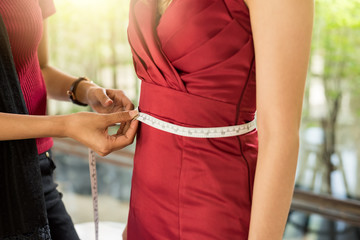






No Comments